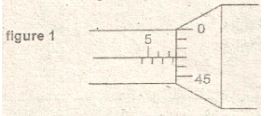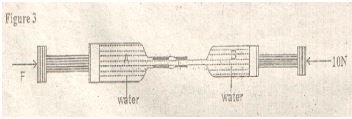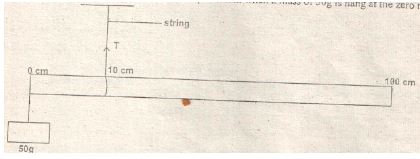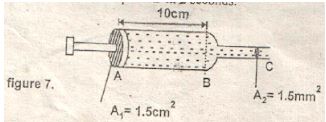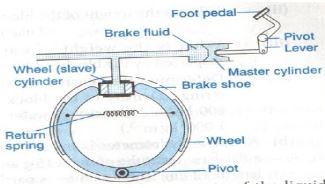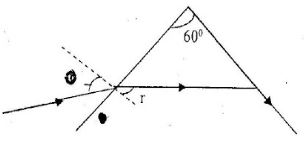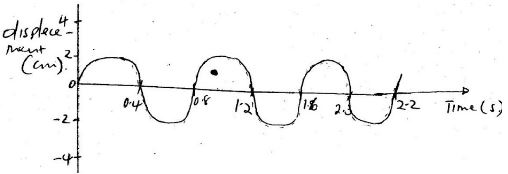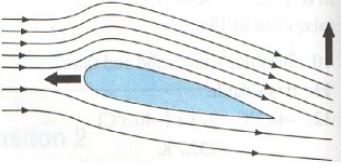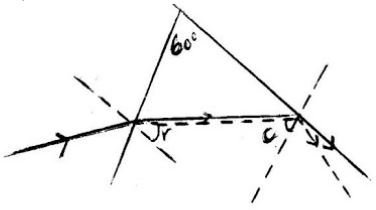INSTRUCTIONS TO CANDIDATES
- This paper consist of two section A and B
- Answer all questions in section A and B
- All working must be clearly shown.
- Non- Programmable silent electronic calculators and KNEC mathematical tables may be used
SECTION A 25MKS
Answer all the questions in this section in the spaces provided.
- Figure 1 shows a micrometers screw gauge with negative zero error of 0.02mm uses to measure the diameter of a ball bearing
Determine the actual diameter of the ball bearing (2mks) - A wooden block resting on a rough surface is pulled by applying a horizontal force F as shown in figure 2.
Indicate on the diagram, all the forces acting on the block other than the weight of the block (2mks) - The diameter of cylinder A in figure 3 is double that of cylinder B
Determine the force F necessary to keep the system in equilibrium when a force F is applied as shown (3mks) - State one factor affecting the rate of diffusion of gases (1mk)
- Figure 4 shows a simple fire alarm
Explain how the alarm functions (1mk) - Figure 5 shows two identical containers A and B containing equal amounts of water an identical ice blocks
State with reason, which water cools faster, assuming the gauze absorbs negligible heat (2mks) - Figure 6 shows a suspended uniform meter rule in equilibrium when a mass of 50g is hang at the zero mark
Determine the tension T in the string (3mks) - A Bunsen burner in the laboratory can be tilted over a large angle and still get back to its original position once the tilting force is withdrawn. State two factors that are responsible for this observation (2mks)
- Figure 7 show a syringe full of water. The area of the piston is 1.5cm2 while the area of the outlet is 1.55mm2 The piston is pushed such that it moves from point B in 2 seconds
Determine the velocity of water at the outlet (3mks) - Sketch a velocity time graph for a body that is uniformly accelerated (1mk)
- A high jumper loads on saw dust. Explain how the saw dust helps in reducing the force of impact (2mks)
- A bullet of mass 20g moving with a velocity of 30m/s penetrates a sand bag and is brought to rest in 0.05s. Find the average retarding force of the sand (3mks)
SECTION B 55 MKS
-
- State Hooke’s law for a spiral spring (1mk)
- In an experiment, a spiral spring was hung vertically from a stand and various weights attached in turn to its lower end. The extension of the spring for the various weight was noted. The results were recorded as shown in the following table.
Load(N) 0 0.2 0.4 0.6 0.8 1.0 1.1 Extension (cm) 0 0.95 1.9 2.9 3.9 5.5 7.25 - Plot the graph of load (y-axis) against the extension of the spring(x-axis)(5mks)
- From the graph, determine the elastic limit of the spring (1mk)
- From the graph, determine the spring constant within Hooke’s law (4mks)
-
- State what is meant by streamline flow. (1mk)
- The figure below shows the cross section of an aeroplane wing (aerofoil), with the aeroplane moving in the direction shown by the arrow.
- Sketch streamlines to show how air flow fast the with as the aeroplane moves (1mk)
- Explain how dynamic lift of the aeroplane is caused by the wing. (3mks)
- A water pipe of diameter 5.2cm is connected to another pipe of diameter 1.3cm. The speed of the water in the smaller pipe is 3ms-1. What is the speed of the water in the larger pipe? (3mks)
-
- Explain how a person is able to draw milk from a glass using a straw (2mks)
- The following diagram shows a simplified hydraulic braking system of a car.
- State the property of the liquid (oil) that makes it more suitable for use as a brake fluid than a gas (1mk)
- Explain how the system works, starting from when the driver presses the foot pedal (4mks)
- Why would the system not function properly if air leak into the cylinder? (1mk)
-
- In an experiment to demonstrate Brownian motion, smoke was placed in an air cell and observed under a microscope, Smoke particles were observed to move randomly in the cell.
- Explain the observation (1mk)
- Give a reason for those of smoke in this experiment (1mk)
- What would be the most likely observation if the temperature in the smoke cell was raised? (1mk)
- An oil drop of average diameter 0.7mm spreads out into a circular patch of diameter 75cm on the surface of water in trough.
- Calculate the average thickness of a molecule of oil (4mks)
- State two assumptions made in (i) above when calculating the thickness of the oil molecule (2mks)
- In an experiment to demonstrate Brownian motion, smoke was placed in an air cell and observed under a microscope, Smoke particles were observed to move randomly in the cell.
- The figure below shows path of ray of yellow light through a glass prism. The speed of yellow light in the prism is 1.88 x 108m/s.
- Determine the refractive index of the prism material for the light (speed of light in vacuum = 3.0 x 108m/s (3mks)
- Show on the diagram the critical angle C, and determine its value. (1mk)
- Given that r=21.2°, determine angle Ө (3mks)
- On the same diagram sketch the path of the light after striking the prism if the prism was replaced by another of similar shape but lower refractive index (use dotted line for your answer ) (2mks)
- The figure below shows a wave profile
Determine- The period of the wave ( ½ mk)
- The amplitude of the wave ( ½ mk)
- If the velocity of the wave is 4m/s, calculate the wavelength of the wave (2mks)

Marking Scheme
- Figure 1 shows a micrometers screw gauge with negative zero error of 0.02mm uses to measure the diameter of a ball bearing
Determine the actual diameter of the ball bearing (2mks)
Actual diameter
=(7.50+0.47) + 0.02
=7.97 + 0.02
=7.99mm - A wooden block resting on a rough surface is pulled by applying a horizontal force F as shown in figure 2.
Indicate on the diagram, all the forces acting on the block other than the weight of the block (2mks)
- The diameter of cylinder A in figure 3 is double that of cylinder B
Determine the force F necessary to keep the system in equilibrium when a force F is applied as shown (3mks)
F1 = F2 or F1A2 =F2A1
A1 A2
F1 × π (d/2)2 =10 × π × (2d/2)2
F1 × d2 =10d2
4
F1 =40N - State one factor affecting the rate of diffusion of gases (1mk)
- Temperature
- Density of the gas.
- Figure 4 shows a simple fire alarm
Explain how the alarm functions (1mk)- When there is fire, temperature rises, mercury expands and touches terminal X: circuit is completed, current flows and the bell rings.
- Figure 5 shows two identical containers A and B containing equal amounts of water an identical ice blocks
State with reason, which water cools faster, assuming the gauze absorbs negligible heat (2mks)- Water in container A
- Cold water is denser than warm water, hence sinks to the bottom setting up convection currents.
- Figure 6 shows a suspended uniform meter rule in equilibrium when a mass of 50g is hang at the zero mark
Determine the tension T in the string (3mks)- Clockwise moments = anticlockwise moments
W = 40/100 × 50/1000 × 10 × 10/100
40W = 5
W =0.125N
Tension in the string = 0.5 + 0.125 = 0.625N
- Clockwise moments = anticlockwise moments
- A Bunsen burner in the laboratory can be tilted over a large angle and still get back to its original position once the tilting force is withdrawn. State two factors that are responsible for this observation (2mks)
- It has a wide base area.
- Has a heavy base.
- Figure 7 show a syringe full of water. The area of the piston is 1.5cm2 while the area of the outlet is 1.55mm2 The piston is pushed such that it moves from point B in 2 seconds
Determine the velocity of water at the outlet (3mks)
A1V1 =A2V2
1.5 × 10/2 =1.5 × 10−2 V2
V2 = 1.5 × 5
1.5 × 10−2
=500cm/s or 5m/s - Sketch a velocity time graph for a body that is uniformly accelerated (1mk)
- A high jumper loads on saw dust. Explain how the saw dust helps in reducing the force of impact (2mks)
- Saw dust increases stopping time; this reduces the rate of change of momentum which is force.
- A bullet of mass 20g moving with a velocity of 30m/s penetrates a sand bag and is brought to rest in 0.05s. Find the average retarding force of the sand (3mks)
a= v−u = 0−30 = −600m/s2
t 0.05
F = ma
= 20 × −600
1000
=−12N
SECTION B 55 MKS
-
- State Hooke’s law for a spiral spring (1mk)
- The extension of a spring is directly proportional to the force applied provided the elastic limit is not exceeded.
- In an experiment, a spiral spring was hung vertically from a stand and various weights attached in turn to its lower end. The extension of the spring for the various weight was noted. The results were recorded as shown in the following table.
Load(N) 0 0.2 0.4 0.6 0.8 1.0 1.1 Extension (cm) 0 0.95 1.9 2.9 3.9 5.5 7.25 - Plot the graph of load (y-axis) against the extension of the spring (x-axis)(5mks)
A- 1mk
S-1mk
P-2mks
L-1mk - From the graph, determine the elastic limit of the spring (1mk)
- 0.80N
- From the graph, determine the spring constant within Hooke’s law (4mks)Spring constant = F/e
= slope = dL/de = 0.8N
3.8 × 10−2m
=21Nm−1
- Plot the graph of load (y-axis) against the extension of the spring (x-axis)(5mks)
- State Hooke’s law for a spiral spring (1mk)
-
- State what is meant by streamline flow. (1mk)
- A flow in which every particle of fluid passing a point follows the path of the preceding particle.
- The figure below shows the cross section of an aeroplane wing (aerofoil), with the aeroplane moving in the direction shown by the arrow.
- Sketch streamlines to show how air flow fast the with as the aeroplane moves (1mk)
- Explain how dynamic lift of the aeroplane is caused by the wing. (3mks)
- The above awing moves faster than the air below. Pressure above wing is reduced. The resulting pressure difference creates a lift.
- Sketch streamlines to show how air flow fast the with as the aeroplane moves (1mk)
- A water pipe of diameter 5.2cm is connected to another pipe of diameter 1.3cm. The speed of the water in the smaller pipe is 3ms-1. What is the speed of the water in the larger pipe? (3mks)
A1V1 =A2V2
A1 = π(2.6cm)2
A2 =(0.65cm)2
π(2.62)cm3 × V1ms−1
=π(0.625)cm2 × 3ms−1
V2 =0.19ms−1
- State what is meant by streamline flow. (1mk)
-
- Explain how a person is able to draw milk from a glass using a straw (2mks)
- When one sucks from the straw the pressure inside the straw is reduced. This allows the atmospheric pressure on the surface of the milk to push the milk up the straw and into the mouth.
- The following diagram shows a simplified hydraulic braking system of a car.
- State the property of the liquid (oil) that makes it more suitable for use as a brake fluid than a gas (1mk)
- Oil is incompressible.
- Explain how the system works, starting from when the driver presses the foot pedal (4mks)
- When the driver steps on the foot pedal, the force is transmitted through the level system to the piston in the master cylinder. The pressure produced in the master cylinder is transmitted through the fluid to the wheel (or slave) cylinders where the pistons in turn push the brake shoes outwards. When the brake shoes are pushed out, the brake-lining presses on the rotating wheel causing the car to slow down or to stop.
- Why would the system not function properly if air leak into the cylinder? (1mk)
- Air is compressible and so the force exerted would be partially used to compress the air instead of pushing out the break shoes.
- State the property of the liquid (oil) that makes it more suitable for use as a brake fluid than a gas (1mk)
- Explain how a person is able to draw milk from a glass using a straw (2mks)
-
- In an experiment to demonstrate Brownian motion, smoke was placed in an air cell and observed under a microscope, Smoke particles were observed to move randomly in the cell.
- Explain the observation (1mk)
- Fast moving air molecules move continuously and randomly and collide with the smoke particles.
- Give a reason for those of smoke in this experiment (1mk)
- Larger particles may not be moved much by the fast moving air particles.
- What would be the most likely observation if the temperature in the smoke cell was raised? (1mk)
- Increase in air temperature would increase the speed of air molecules and hence the number of collisions would be more.
- Explain the observation (1mk)
- An oil drop of average diameter 0.7mm spreads out into a circular patch of diameter 75cm on the surface of water in trough.
- Calculate the average thickness of a molecule of oil (4mks)
Volume of the oil drop
= 4/3π3 = 4/3 x 3.14 x 0.0353 cm3
let the thickness be = x
volume of the patch = π R2x
= 3.14 x (37.5)2 cm2 × x
Volume of the patch = volume of the oil drop.
3.14x (37.5)2 cm2 × x = 4/3 x 3.14 x (0.035)3 cm3
x = 4/3 x (0.035)3cm3 x 1
(37.5)2
= 4.066 x 10−8cm
= 4.066 x 120−10 m
= 4.1 x 10−10 m. - State two assumptions made in (i) above when calculating the thickness of the oil molecule (2mks)
- the oil does not evaporate
- the oil spreads to a one molecule thick layer.
- Calculate the average thickness of a molecule of oil (4mks)
- In an experiment to demonstrate Brownian motion, smoke was placed in an air cell and observed under a microscope, Smoke particles were observed to move randomly in the cell.
- The figure below shows path of ray of yellow light through a glass prism. The speed of yellow light in the prism is 1.88 x 108m/s.
- Determine the refractive index of the prism material for the light (speed of light in vacuum = 3.0 x 108m/s (3mks)
n = C/V
= 3 x 108
1.88 x 108
= 1.596
= 1.6 - Show on the diagram the critical angle C, and determine its value. (1mk)
Sin C = 1/n
= 1
1.596
C = 38.8° - Given that r=21.2°, determine angle Ө (3mks)
n = sin θ
sin r
1.596 = sin θ
sin 21.2
θ = 35.25 - On the same diagram sketch the path of the light after striking the prism if the prism was replaced by another of similar shape but lower refractive index (use dotted line for your answer ) (2mks)
- Determine the refractive index of the prism material for the light (speed of light in vacuum = 3.0 x 108m/s (3mks)
- The figure below shows a wave profile
Determine- The period of the wave ( ½ mk)
- period (T) = 1.65
- The amplitude of the wave ( ½ mk)
- Amplitude = 4cm
- If the velocity of the wave is 4m/s, calculate the wavelength of the wave (2mks)
^ = fy
^= v/f
f = 1/T = 1 = 0.625
1.6
^ = 4
0.625
= 6.4m
- The period of the wave ( ½ mk)
Download Physics Paper 1 Questions and Answers - Form 3 Mid Term 1 Exams 2021.
Tap Here to Download for 50/-
Get on WhatsApp for 50/-
Why download?
- ✔ To read offline at any time.
- ✔ To Print at your convenience
- ✔ Share Easily with Friends / Students

